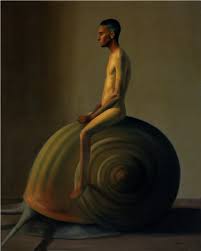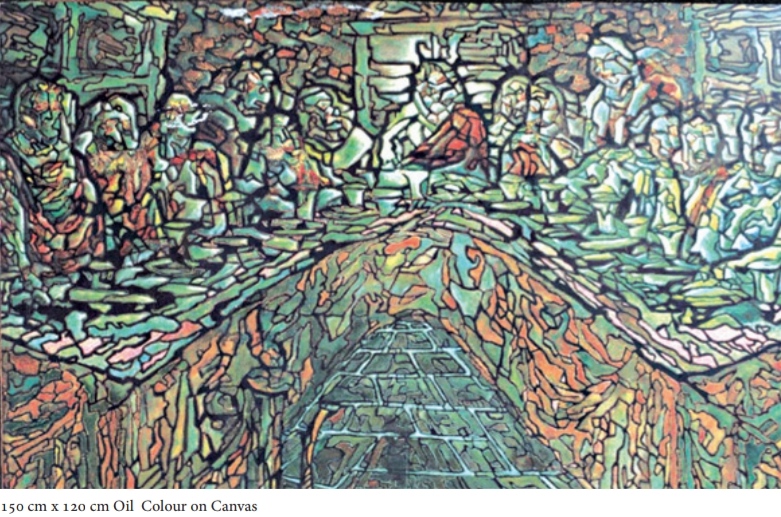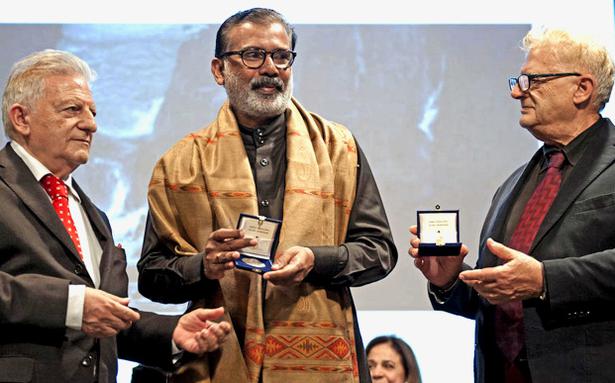
Francis Kodankadath IRS / Aneesh Kuttan/ Uma Rao
An in-depth analysis of the Francis Kodankandath paintings reveal the manner in which the painter chooses the subjects for each of his paintings.
He goes out towards nature, he looks within life, he observes the world around him, he internalizes his experiences and these become the subject matter of each of his paintings.
Every painting of this artist comes with a deep, significant message. Though the artist draws on a fixed, measured canvas, he aims at transferring a meaningful note on an immeasurable scale to the viewer. In the process, if the artist succeeds in conveying through a painting made on a limited canvas, the message which in printed medium would need a book of thousands of pages, he believes he has succeeded in his mission.
This would be the assessment made by everyone who views his painting titled ‘Those Who Remain’. Francis has painted a photo within a picture. ‘Those Who Remain’ thus becomes a picture-story of those who are left after the demise of one among them.
This painting won the ‘Highly Commended Certificate’ by Kerala Lalithakala Akademi in 1989. This was the second State level recognition for Francis Kodankandath after three years. It could be the inherent connect of this painting, which conveyed a basic truth, reaching out to everyone, going beyond the barriers of land and language that bestowed a position to this painting in the international exhibition titled ‘Universal Families’ held under the auspices of the United Nations Population Fund (UNFPA).
A gentle probe at the motivation that led to painting this picture would give the reader an overview of the family history of the Kodankandaths.
The ancestral house of Kodankandath was situated in the Manalur Panchayath of Thrissur district. Theirs was a family of agriculturists with a lineage going beyond four hundred years. The artist’s grandfather’s name was Porinchu. “Porinchu” was tweaked to Francis and thus the artist was named so by the family. Francis lived with his grandmother and his father’s brothers at this ancestral house. His father, K P Antony was a Professor in Chemistry in the St Thomas College at Thrissur. His father would travel a distance of twelve kilometers every day to the college from Manalur and would get back home in the evening. The eldest son Francis, till the age of four, grew up at this ancestral house, along with his two younger brothers. For the convenience of schooling the children, the father bought a house near the Bishop’s Palace at East Fort in Thrissur. On the day the family was to move to Thrissur, his grandmother expressed a desire to have a family photo taken of all of them together, may be due to the realization that one branch of the joint family was about to become nuclear. Immediately his father asked a photographer from Kanjany, a town nearby, to come home for the purpose. All the family members stepped out to the courtyard in front of the house. While the men stood in a row, the ladies sat on chairs lined across before them and the children sat cross-legged on the mats spread in front of the chairs. As everyone posed for the photograph, the grandmother cried softly. This caught the attention of the artist’s father. Upon being asked by him, grandmother replied, “It’s nothing. Your father died when you were just seventeen years old. I wished he too were here with us now…!”
Then, steeling himself up, the artist’s father declared, “Who said our father isn’t here with us? He hasn’t gone anywhere. He is here and will come here now!” He then placed a chair near his mother’s, went up to the balcony in front of the house, where hung a huge black and white photo of grandfather, removed that and placed it gently on the vacant chair near hers. With this, grandmother felt composed and all were relieved. When they got the print of the photograph,the children were ecstatic.
The shed, visible in the background of the photo, housed two buffaloes, Maani and Kuttan, who were very much a part of the household. Both their heads were clearly imprinted on the photo. When the photo was taken, both of them had raised up their heads to peer into the camera.This was absolutely a coincidence. Everyday when the two would be taken to the pond near the sacred grove for a wash, all the children would be seated atop the two, on a ride to the pond! It was indeed very good that Maani and Kuttan, with whom the entire family shared such a close bonding, also figured in the family photo. This photo was kept for a very long time in the ancestral house. Later when a part of the house was being modified, the photo got damaged.
But the photo was firmly imprinted in the artist’s mind. ‘Those Who Remain’ was the outcome of a desire that came to the artist’s mind years later to recreate the family photo. The subject of the painting was that except grandfather, all the rest of the family members figuring in the photograph were those who remained at that point of time. This was a painting that sprang out of the artist’s own personal experience.
The artist says that often it would take days, weeks and months for one single painting to take shape. Oil paintings required a longer time to dry. He shares a particular incident to corroborate the point.
The artist’s younger daughter, Kunjumary was then two years old. The artist had kept a completed painting on the floor of a room for it to dry. On such occasions, the room would be kept locked. But on a holiday, in the course of painting, the artist had just stepped out of the house for a short while on an errand. When he reached back home, his wife told him in distress, “I was busy in the kitchen!”
As Kunjumary was playing, she had crawled into the room where the painting had been kept to dry. She had sat on the painting and slowly moved around. Upon looking at the canvas, the painter realized that his little daughter had sat on the unpainted white portion of the canvas and moved about and hence grains of dust from her body had got embedded on the painting in a few parts.
When the artist saw this painting after a while, he was amazed. The dust marks gave the painting an antique appearance. Today his daughter Kunjumary herself has a six year old daughter, Niah Mary!
On several occasions, when the artist painted, he had experienced a divine presence and grace. All his paintings are imprinted with that grace.
Francis had painted a photo within the painting. Usually such paintings were like a remembrance of those who were no longer there. But the particular painting spoke more of those who lived on. At present, the artist’s uncle, Kunhippalu Master, who was a teacher, lives in that ancestral house with his family. Hence the artist captioned his painting. ‘Those Who Remain’, a painting that won the hearts of thousands of art lovers and which is now a part of the personal art collection in Chennai, owned by Sara Abraham, who also owns a prized collection of the paintings of the renowned artist M F Hussain and other famous artists.









